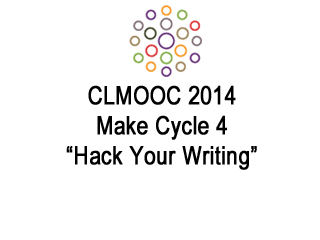In Make Cycle #4 we invite you to “Hack Your Writing.” Maybe you do not think you’re a “hacker” and associate the term exclusively with the most skillful and renegade of computer programmers. But this week we are encouraging a broader use of this term and a more open sense of its possibilities.
What does it mean to hack?
- Hacking is playful exploration, perhaps exploiting the “weakness” in something.
- To hack is to make innovative customizations.
- Hackers are often computer enthusiasts.
- Hackers often undermine authoritative systems. Hackers crack systems for “fun,” pursuing civic or collective action.
It seems that now, more than ever, the affordances of new digital tools and technologies have opened up our understanding of what it means to write. This week we are invoking a culture of remix and exploration. We propose that writing is indeed “making,” and we invite you to tinker with some writing to make something new. Remix your own writing OR remix other writing.
So Many Ways to Hack
We imagine there are multiple entry points for this week’s make cycle. One option might be to revisit something you wrote before and “dress it up” anew. If you have a notebook or journal that you’ve scribbled in, if you have jotted down a fleeting poem, or if perhaps you have penned an essay or article, this week’s make cycle might involve revisiting an old writing moment and breathing new life into a former work. Perhaps you might want to take several different pieces of writing and put them together to create a collage or compilation? Go for it!
Your own “hack” job might involve seeing something new in the everday texts of your life. Consider taking some pieces of your written world, the everyday stuff like grocery lists, fortune cookie predictions, or your favorite quote that you have up on your wall in your home or office. Re-discover the words around you, refashion them, re-order them. The literary equivalent of a collage, found poetry is often made from newspaper articles, street signs, graffiti, speeches, letters, or even other poems.
Your hacking exploration might bridge old methods of writing with the new. Consider hacking your own notebook. You can try “Paper Circuitry” as you light up your writing by creating circuits on paper using copper tape, LEDs, and some simple electronics. What new composing practices might emerge from this hack? And what new meaning and understanding might we gain as writers or as readers?
In other words, you might put analog and digital texts into conversation. Take some analog writing and bring it into a digitized universe.
- You might take a traditional poem and layer a multi-modal interpretation via hypertext links.
- Use the Scratch program to explore new ways of writing and composing (just press the remix button to reinvent or animate texts).
- You can give the “Concept in 60” digital writing method a try by demonstrating skills in audio and video recording and editing to create a rhetorically effective text.
- Have you ever transformed your keyboard and your writing process with a Makey Makey?
- Or how about creating a real life treasure hunt driven by digital narrative? Use your cell phone, GPS technology, and multimedia content to enhance your reader’s connection to a given place by giving locative storytelling a shot.
In short, we imagine there are many ways to infuse your “writing hack” with new found interactivity.
Check out some of these resources:
Classroom Connections: Lesson Plan from ReadWriteThink
Paper Circuitry “Hack Your Notebook” Day
“The Concept in 60” assignment overview
An additional list of media tools can be found by clicking HERE.
And don’t forget to share what you do by adding an example below!



